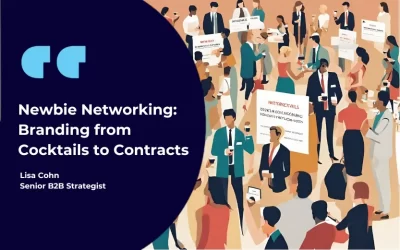When events are permitted in future, will large-scale ones be the best way to reach B2B audiences and generate sales? What does the future of B2B events look like?
The future of B2B events – the before
Pre-Covid-19, the B2B marketing world was awash with business events — breakfast meetings, round tables, networking events, conferences, trade shows, expos and expert speaker engagements — all generally really strong B2B marketing properties. Yet, because there were so many of them, only the truly exceptional ones gained traction.
There was always a debate around when to host the event: It couldn’t be in the late afternoon, because people were tired. Not midday, because people couldn’t get out of the office. An early breakfast event? Challenging in the face of traffic and school-run logistics. Instead of the focus of the event being tactical, it turned into an exercise to just get people in — we found clients phoning friends, family and having their agencies pile in en masse, all just to get bums on seats so the CEO saw a full house.
While that’s not a reality for the foreseeable future of B2B events the new challenge is digital fatigue. If we spend all day in Zoom meetings, do we really want to spend more time in front of a screen, for a webinar?
The future of B2B events – the issues
If I look back at the events that stood out, they were the ones where a company brought an international speaker in or were hosted in an amazing venue that people largely hadn’t been to yet. These things bumped up the price but were impactful, the problem being that it was hard to replicate that experience each time. Another problem was that the type of content you got at events was freely available all over the web. If you want to understand what’s happening in your category, a quick Google Search will deliver plenty of free industry insights from the very experts the company paid to present.
Lockdown has seen those industries able to make effective changes thrive — and that applies to the future of B2B events space, too. “Pivot” may have become a four-letter word but companies which have embraced digital processes wholeheartedly across every aspect of operations — including communicating their messages — are the ones which are keeping their heads above water, if not growing. Some have found themselves ideally positioned (look at the way Zoom’s share price has rocketed from US$68 on 2 January 2020 to US$267 on 5 August 2020).
The stalling of the trade show and conferencing industry has seen companies having to find other ways to connect with their markets, as they don’t simply stop trading. As more people realise that this kind of digital connection is actually a workable solution for the future of B2B events, it’s clear that it’s going to affect the way companies communicate, even once the threat of the Coronavirus has been contained.
Come a long way
Webinars have come a long way over the past few years; they used to require people to log in at a specific time and to suffer through a poorly-produced presentation over a flimsy connection, hosted on a platform that wasn’t designed to deliver information that particular way. Now, we have dedicated webinar-delivery platforms which offer a much-better experience. The opportunity to pre-record a webinar to be consumed by customers at a time of their choosing has allowed for better production values, and there are all manner of additional content elements that may be tagged onto the presentation (the webinar running in one window, surrounded by interactive supporting information such as widgets, graphs and downloads).
The beauty of this is that companies can track how people interact with those additional elements to help them establish what their customers’ needs are, and where they are in the purchase journey. This is a powerful tool for the future of B2B events if managed properly. Armed with that knowledge, the business can open up a stream of communications, post-viewing, which is where all the value sits. They know where their customers are in the sales funnel and can tailor content accordingly to get them converted. That’s infinitely more valuable that sending someone on their way at the end of a trade event, clutching a goodie bag and a stack of business cards.
Events will eventually come back but not in the same way they were run before. Why spend millions in building a stand in a cluttered exhibition hall at a trade show when you could spend much smaller amounts on producing quality content and generating more powerful leads?
How to start
- Start small by digitising a few events and see how things go. If it works, try a few more.
- Then have a roadmap for the next 3–5 years which reflects the insights you’ve gained from what your customers have engaged with most.
- Events will be hybrids, e.g, attending a physical trade show could cost R10 000 but the digital experience could be priced at R6 000.
When it comes to the future of B2B events, this opportunity for cost-saving on the ends of the equation will help companies produce better digital engagements — and focus the budget which still needs to be spent on physical events much better.
In line with this article, you might be interested in reading how anthropology can enhance your sales training. Read it here.
This article, by Warren Moss, originally appeared on MarkLives.com but has been edited slightly for SEO purposes.



